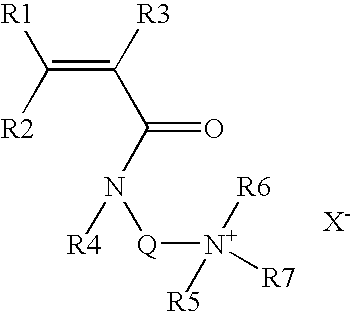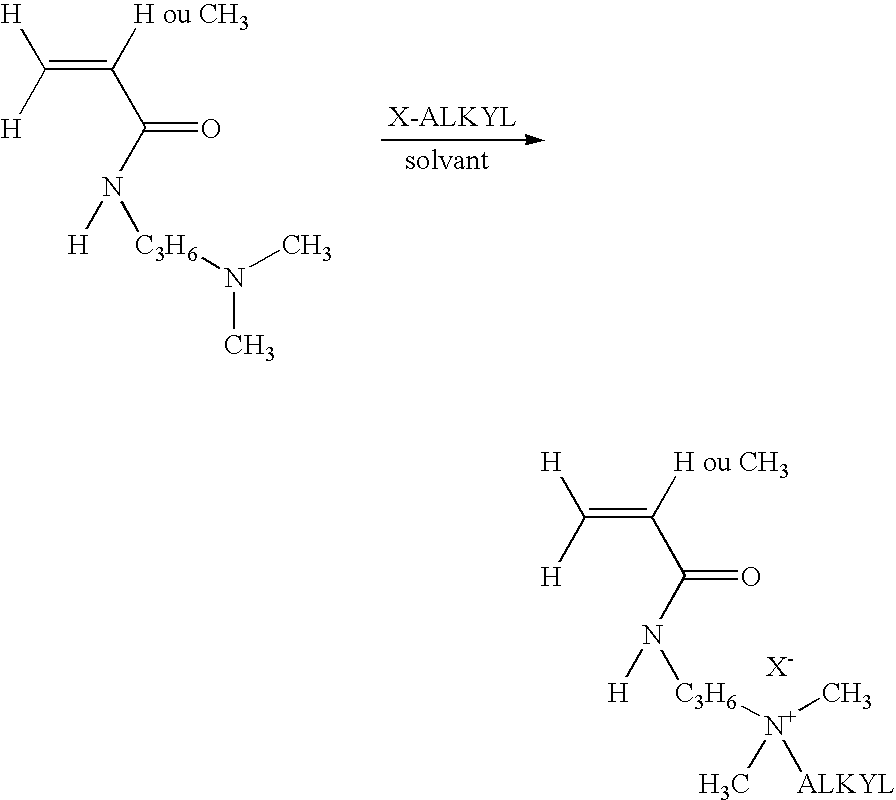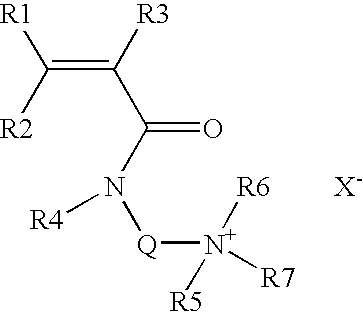High molecular weight associative amphoteric polymers and uses thereof
a polymer and amphoteric technology, applied in the field of new associative amphoteric polymers, can solve the problems of very rapid solubilisation or swelling of polymers, reducing the viscosity of sharp cuts, and none of aforementioned products has undergone industrial developmen
- Summary
- Abstract
- Description
- Claims
- Application Information
AI Technical Summary
Problems solved by technology
Method used
Image
Examples
example 1
Viscosifying Effect of the Polymers in the Invention in Relation to their Conditions of Use
[0060]The powders obtained were solubilised in various brines and the viscosity of the solutions was measured under different conditions of shearing and temperature. The results are given in tables 1, 2 and 3.
[0061]Unless indicated, the counterion of the cationic monomer is a chloride, x corresponds to the mole percentage of the hydrophobic cationic monomer(s) and y corresponds to the mole percentage of the anionic monomer.
[0062]
TABLE 1measurement of the viscosity of the associative amphotericproducts in deionised water at 20° C.ViscosityViscosityx / yMwC(cps)(cps)R7mole %(106 g · mol−1)(ppm)at 7 s−1at 100 s−1Ag1C12H250.7 / 27 6.410,0009,780685aAp2C18H375 / 200.240,0002,350660aAg3C12H251 / 272.5 5,0001,040205a
[0063]
TABLE 2measurement of the viscosity of the associative amphoteric products in brines at 24° C.Saltx / yMwCconcentration inViscosityR7mole %(106 g · mol−1)(ppm)the brine (ppm)(cps)Ag4C18H370....
example 2
Relative Viscosity Test
[0065]To precisely compare the efficacy (viscosifying power) of the products in the invention, various polymers were prepared under strictly identical conditions: same procedure (cf. preparation of the polymer) and same molar compositions, according to the following table.
[0066]
Non-ionicmonomerAnionicCationic monomerHydro-monomerHydrophobicNonphobicNon-Acrylamido-Allyl-hydro-Acrylate-hydro-typetypephobictypephobicInv.YESYESxanioNONONONOYESxamphoNONOYESNOYESxHamphoNONOYESYESYESxHLamphoNOYESNONOYESxHcatioYESNONONONO
[0067]The viscosity of the products noted x (Vx) was compared with that of the polymers in the invention (Vinv) under various conditions (deionised water, brine, at different concentrations and at different temperatures).
[0068]Coefficient R, which is expressed in a percentage, is defined by the following relation:
R=((Vinv−Vx) / Vx)×100
[0069]The higher R is, the more the viscosifying power of the polymers in the invention differs from that of the “standa...
PUM
| Property | Measurement | Unit |
|---|---|---|
| diameter | aaaaa | aaaaa |
| weight average molecular weight | aaaaa | aaaaa |
| Mw | aaaaa | aaaaa |
Abstract
Description
Claims
Application Information
 Login to View More
Login to View More - R&D
- Intellectual Property
- Life Sciences
- Materials
- Tech Scout
- Unparalleled Data Quality
- Higher Quality Content
- 60% Fewer Hallucinations
Browse by: Latest US Patents, China's latest patents, Technical Efficacy Thesaurus, Application Domain, Technology Topic, Popular Technical Reports.
© 2025 PatSnap. All rights reserved.Legal|Privacy policy|Modern Slavery Act Transparency Statement|Sitemap|About US| Contact US: help@patsnap.com



